Trong sản xuất viên nén, nghiền nguyên liệu thô và tạo hạt trước khi tạo viên là những bước quan trọng để xác định chất lượng và độ đồng nhất của viên nén. Việc nắm vững cách sử dụng các quy trình này và thiết bị của chúng không chỉ có thể cải thiện hiệu quả của ép viên sản xuất, mà còn đảm bảo tính ổn định và an toàn của sản phẩm cuối cùng. Bài viết này sẽ giải thích chi tiết các khía cạnh quan trọng của quá trình nghiền và tạo hạt và đưa ra khuyến nghị về các thiết bị liên quan.
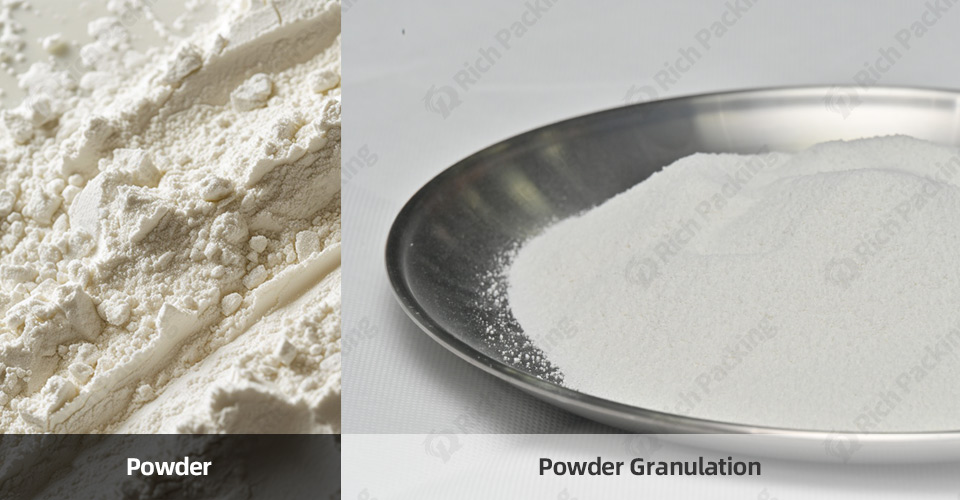
Nghiền và tạo hạt là những bước quan trọng trong quy trình sản xuất viên nén, quyết định chất lượng viên nén thành phẩm và hiệu quả của quá trình tạo viên. Trong sản xuất dược phẩm, cần phải xử lý các hạt hoặc cục vật liệu lớn thành các hạt phù hợp để tạo viên. Kích thước và hình dạng hạt phù hợp có thể cải thiện hiệu quả độ chảy và độ nén của viên nén, đảm bảo quá trình tạo viên trơn tru và giúp viên nén thành phẩm có trọng lượng, độ cứng và thời gian rã đồng đều. Ví dụ, hạt quá lớn có thể khiến độ cứng của viên nén không đồng đều trong quá trình nén, trong khi hạt quá nhỏ có thể ảnh hưởng đến độ hòa tan của viên nén. Do đó, việc tối ưu hóa các bước nghiền và tạo hạt không chỉ giúp cải thiện năng suất mà còn đảm bảo chất lượng sản phẩm đồng đều.
Nghiền là quá trình xử lý nguyên liệu thô lớn thành các hạt mịn hoặc bột để chuẩn bị cho quá trình tạo hạt và nén viên tiếp theo. Bạn cần cân nhắc độ cứng, độ ẩm và các đặc tính vật lý của nguyên liệu thô khi lựa chọn thiết bị nghiền để đảm bảo độ đồng đều và độ chảy của các hạt cuối cùng. Dưới đây là một số loại thiết bị nghiền phổ biến và ứng dụng của chúng.
Phân loại và ứng dụng của thiết bị nghiền:
|
Loại thiết bị |
Kịch bản ứng dụng |
Lợi thế |
Thiếu sót |
|
Cối xay khí |
Vật liệu nhạy cảm với nhiệt độ cần xử lý ở nhiệt độ thấp |
Tốc độ cao, không gây ô nhiễm |
Tác động kém đến vật liệu cứng |
|
Máy nghiền hiệu suất cao |
Nguyên liệu thô có khối lượng lớn, độ cứng cao |
Nhanh chóng, hiệu quả và thích ứng |
Xử lý hạn chế các vật liệu nhạy nhiệt |
|
Máy nghiền búa |
Thích hợp cho các vật liệu có độ cứng trung bình và giòn như thảo mộc, vật liệu thực vật khô |
Dễ vận hành, chi phí thấp |
Không thích hợp cho việc nghiền siêu mịn, độ ồn cao |
|
máy nghiền bi |
Thích hợp cho việc nghiền bột siêu mịn, chẳng hạn như phá vỡ tế bào, vật liệu nano |
Độ mịn cực cao |
Tiêu thụ năng lượng cao và thời gian nghiền lâu |
Máy nghiền búa: Đây là thiết bị nghiền thông dụng được sử dụng rộng rãi để nghiền các vật liệu có độ cứng trung bình và giòn, chẳng hạn như thảo mộc, quặng và nguyên liệu thực vật khô. Máy nghiền búa tác động lên vật liệu thông qua búa quay tốc độ cao để nghiền ban đầu và kiểm soát kích thước vật liệu nghiền thông qua sàng. Ưu điểm chính của máy nghiền búa là cấu trúc đơn giản, chi phí thấp, khả năng ứng dụng rộng rãi, đặc biệt được sử dụng rộng rãi trong các nhà máy dược phẩm và phòng thí nghiệm quy mô vừa và nhỏ. Tuy nhiên, cần lưu ý rằng máy nghiền búa có thể hoạt động kém khi xử lý các loại bột đặc biệt mịn hoặc vật liệu đòi hỏi độ chính xác cao. Đồng thời, máy cũng gây ồn khi vận hành và cần được kiểm soát tiếng ồn phù hợp trong môi trường vận hành.
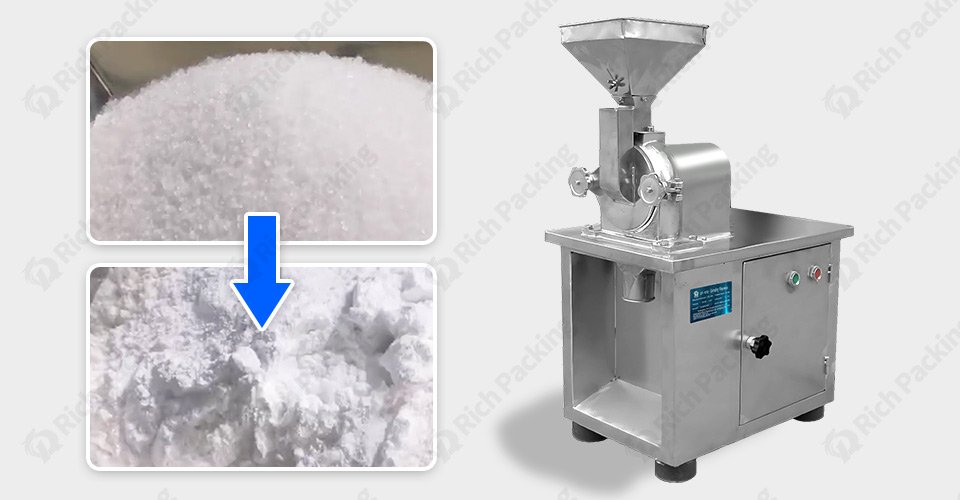
Quy trình tạo hạt ướt được sử dụng để tạo hạt bằng cách trộn bột và chất kết dính lỏng để cải thiện độ chảy và khả năng nén của hạt và đảm bảo tính ổn định của quy trình tạo viên tiếp theo. Quy trình này được sử dụng rộng rãi trong ngành dược phẩm và đặc biệt phù hợp với các sản phẩm yêu cầu độ cứng và đồng nhất cao của hạt.
Phân loại và ứng dụng của thiết bị tạo hạt ướt:
|
Loại thiết bị |
Kịch bản ứng dụng |
Lợi thế |
|
Máy tạo hạt tầng sôi |
Thích hợp để xử lý nguyên liệu thô nhạy nhiệt |
Độ đồng đều của hạt Độ đồng đều của hạt cao, Thích hợp cho sản xuất hàng loạt |
|
Máy trộn hạt |
Thích hợp cho việc tạo hạt nhanh và sản xuất hàng loạt |
Dễ vận hành, phù hợp với sản xuất hàng loạt nhỏ |
|
Máy nghiền quay |
Thích hợp cho các vật liệu có độ nhớt cao, các hạt đồng đều |
Hiệu ứng tạo hạt của vật liệu nhớt tốt và kiểm soát kích thước hạt chính xác hơn |
Máy tạo hạt tầng sôi tạo hạt bằng cách treo bột trong luồng khí đồng thời phun chất kết dính lỏng. Máy này thích hợp để xử lý các vật liệu nhạy nhiệt và đảm bảo tính đồng nhất và độ đặc của hạt, thường được sử dụng trong dược phẩm, thực phẩm và các ngành công nghiệp khác đòi hỏi hạt chất lượng cao.
Ưu điểm của máy tạo hạt khuấy ướt:
Nguyên lý hoạt động của máy tạo hạt khuấy là trộn đều bột và chất kết dính dạng lỏng bằng cách khuấy cơ học, tạo thành hạt đồng đều. Máy tạo hạt khuấy dễ vận hành, đặc biệt phù hợp cho sản xuất hàng loạt quy mô vừa và nhỏ. Tốc độ trộn và liều lượng chất kết dính có thể được điều chỉnh theo đặc tính của từng loại vật liệu, giúp kiểm soát hạt chính xác hơn. So với máy tạo hạt tầng sôi, máy tạo hạt khuấy có giá thành rẻ hơn và phù hợp với môi trường sản xuất có ngân sách hạn chế.
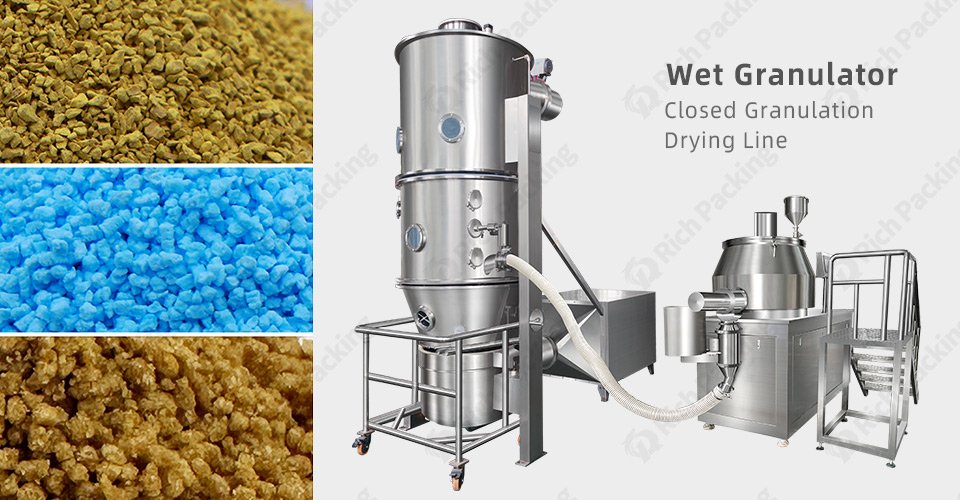
Tạo hạt khô tạo hạt bằng cách nén trực tiếp bột mà không cần thêm chất kết dính lỏng. Phương pháp này đặc biệt phù hợp với các vật liệu không tiếp xúc với chất lỏng, chẳng hạn như một số hoạt chất dễ bị chảy nước, nhạy cảm với nhiệt hoặc không ổn định. So với tạo hạt ướt, tạo hạt khô loại bỏ bước sấy khô và có thể giảm đáng kể mức tiêu thụ năng lượng và thời gian.
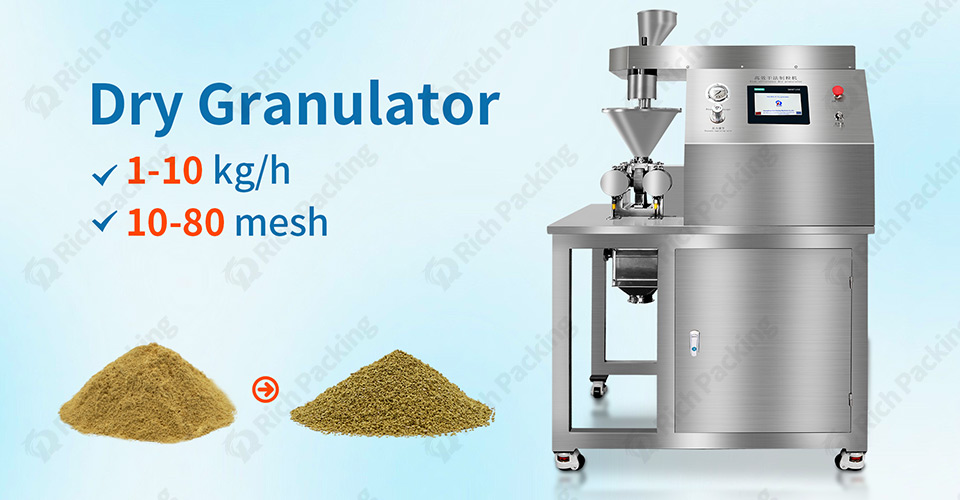
Máy tạo hạt khô nén trục lăn: Bột được nén thành dạng vảy nhờ áp lực giữa hai trục lăn, sau đó được nghiền và sàng để tạo thành hạt. Ưu điểm của máy này là không cần chất kết dính lỏng, đặc biệt phù hợp với các nguyên liệu thô không phù hợp để chế biến ướt. Ngoài ra, việc tạo hạt khô có thể giảm đáng kể mức tiêu thụ năng lượng do không cần bước sấy khô tiếp theo.
Trong quá trình tạo hạt khô, cần đảm bảo nguyên liệu thô có độ nén đủ tốt, nếu không, việc tạo viên kém hoặc mật độ viên không đồng đều có thể xảy ra. Phương pháp này thường phù hợp khi xử lý các thành phần dược phẩm nhạy cảm với độ ẩm hoặc khi cần sản xuất nhanh.
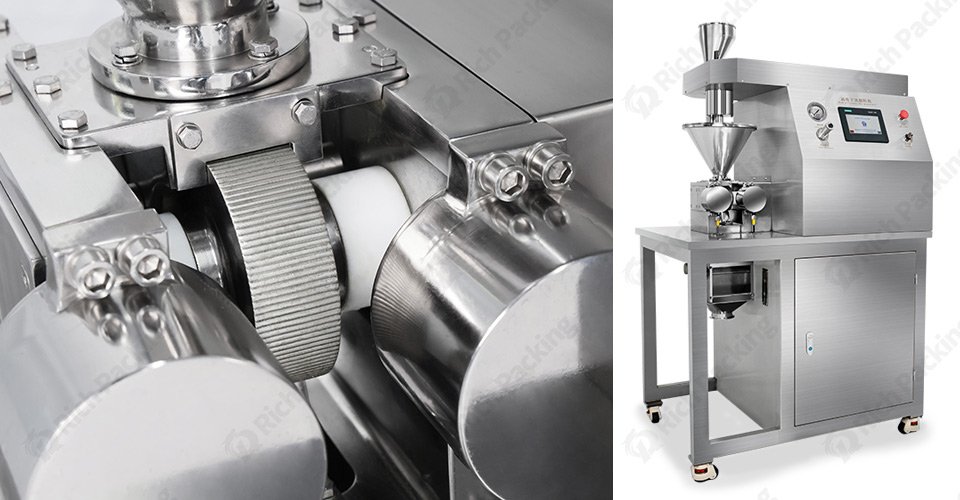
Kích thước hạt và độ đồng nhất là yếu tố quan trọng quyết định chất lượng viên nén cần ép. Các hạt quá lớn hoặc quá nhỏ sẽ ảnh hưởng đến độ chảy và khả năng nén của viên nén, từ đó ảnh hưởng đến độ cứng và độ hòa tan của thành phẩm cũng như khả năng giải phóng tác dụng của thuốc. Việc kiểm soát kích thước hạt trong quá trình nghiền và tạo hạt là một phần quan trọng để đảm bảo độ đồng nhất của viên nén.
Bạn có thể lựa chọn các thiết bị nghiền và quy trình tạo hạt khác nhau cho các sản phẩm thuốc và nhu cầu sản xuất khác nhau. Ví dụ, nghiền mịn đảm bảo độ đồng đều của hạt tốt hơn, trong khi tạo hạt ướt cải thiện khả năng nén hạt. Bất kể thiết bị nào được sử dụng, điều quan trọng là phải đảm bảo các viên có kích thước phù hợp và đáp ứng các tiêu chuẩn sản xuất.
Việc lựa chọn thiết bị phụ thuộc vào quy mô sản xuất, đặc tính của nguyên liệu thô và yêu cầu sản xuất. Nếu bạn đang xử lý vật liệu nhạy cảm với nhiệt độ hoặc cần kiểm soát độ chính xác cao, máy nghiền luồng khí và máy tạo hạt tầng sôi có thể là lựa chọn tốt hơn. Trong khi đó, để xử lý khối lượng lớn vật liệu có độ cứng trung bình, máy nghiền búa và máy tạo hạt khuấy là giải pháp tiết kiệm chi phí hơn.
Ngoài ra, việc tuân thủ GMP của thiết bị, mức độ tự động hóa và chi phí bảo trì là những yếu tố quan trọng cần xem xét. Khi lựa chọn thiết bị, điều quan trọng là phải đảm bảo thiết bị đáp ứng nhu cầu sản xuất cũng như các yêu cầu quy định.
Nghiền và tạo hạt là những bước quan trọng không thể bỏ qua trong sản xuất viên nén. Bằng cách lựa chọn thiết bị và quy trình phù hợp, bạn có thể tăng năng suất và đảm bảo tính đồng nhất cũng như tiêu chuẩn chất lượng cao cho sản phẩm. Hiểu rõ và nắm vững các chi tiết của những quy trình này sẽ giúp bạn đạt được thành công lớn hơn trong sản xuất viên nén.